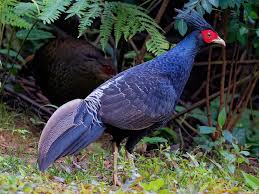
Kalij Pheasant
Lophura leucomelanos
Order:
Family:
Size:
40-50 centimeters
Weight:
800 to 1100 grams
Taxonomy:
L. l. leucomelanos (Latham, 1790) – nominate – forests of Nepal
Short Description:
The Kalij Pheasant (Lophura leucomelanos) is a striking bird species found across various regions of Pakistan, including the northern areas such as Azad Kashmir and Khyber Pakhtunkhwa province. Known for its beautiful plumage, the male Kalij Pheasant showcases vibrant iridescent colors of blue, green, and bronze, while the female boasts more subdued brown and gray feathers for camouflage. These ground-dwelling birds inhabit forests, scrublands, and grasslands, where they forage for seeds, fruits, insects, and small invertebrates. Male Kalij Pheasants typically measure around 55-70 centimeters (21-28 inches) in length, while females are slightly smaller. They are admired for their ornamental beauty and are sometimes kept in captivity for aesthetic purposes.
Far far away, behind the word mountains, far from the countries Vokalia and Consonantia, there live the blind texts. Separated they live in Bookmarksgrove right at the coast
The Kalij Pheasant (Lophura leucomelanos) is distributed across various regions of Pakistan, primarily in the northern areas such as Azad Kashmir and the Khyber Pakhtunkhwa province. These birds can be found in forested habitats, including coniferous and mixed forests, as well as scrublands and grasslands. They prefer areas with dense vegetation where they can forage for seeds, fruits, insects, and small invertebrates.
In Pakistan, the Kalij Pheasant’s distribution may vary based on factors such as altitude, habitat availability, and human activities. While they are relatively common in some areas, their populations may face threats such as habitat loss, hunting, and predation by introduced species. Conservation efforts are important to ensure the continued presence of Kalij Pheasants in the wild in Pakistan.
Ground Foraging: Kalij Pheasants predominantly forage for seeds, fruits, insects, and small invertebrates on the forest floor.
Territoriality: Males may display territorial behavior, defending their territories during the breeding season.
Courtship Displays: Males perform elaborate courtship displays, including vocalizations and plumage displays, to attract females.
Nesting: Females construct ground nests concealed within vegetation, where they lay and incubate eggs.
Vocalizations: Kalij Pheasants utilize various calls for communication, such as alarm calls, mating calls, and territorial calls.
Roosting: They roost in trees or dense vegetation at night, often in communal roosting sites.
Interaction with Humans: Kalij Pheasants may adapt to human-altered habitats but can be sensitive to disturbance, especially during breeding.
Far far away, behind the word mountains, far from the countries Vokalia and Consonantia, there live the blind texts. Separated they live in Bookmarksgrove right at the coast
About Photographer : Hello World
Facebook
Twitter
Instagram
Flicker
LinkedIn

